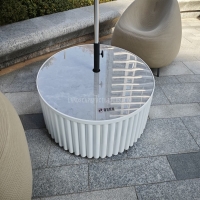Welcome to the website for landscape facilities products and knowledge.
How do landscape bar counters compare to indoor bar counters in terms of material choices and design constraints?
When selecting between landscape and indoor bar counters, material durability becomes the paramount concern. Outdoor installations face constant exposure to sun, rain, temperature fluctuations, and potential moisture damage. This fundamental difference dictates entirely distinct material selection criteria and imposes significant design constraints not present in indoor environments.
For landscape bar counters, the material choices prioritize weather resistance and structural integrity. Stainless steel, particularly grade 304 or 316, offers excellent corrosion resistance for frames and fixtures. Concrete, whether precast or poured in place, provides mass and durability but requires proper sealing. Teak and other dense hardwoods naturally withstand moisture but need regular maintenance. Composite materials designed specifically for outdoor use have gained popularity for their longevity and minimal upkeep. Stone selections like granite must be properly sealed, while some porous stones like marble are generally unsuitable.
Indoor bar counters enjoy greater material flexibility without weather concerns. Designers can incorporate delicate materials like untreated woods, laminates, MDF, and even materials that would quickly degrade outdoors. The focus shifts from weatherproofing to aesthetics, maintenance for spills and stains, and compatibility with interior design themes.
The design constraints for outdoor bars are considerably more rigorous. Structural stability must account for wind loads and potential ground movement. Drainage becomes a critical design element to prevent water accumulation. All electrical components for lighting or appliances require weatherproof ratings and proper installation to prevent hazards. Accessibility for cleaning and maintenance must be designed into the structure, as outdoor counters accumulate debris and require more frequent cleaning.
Indoor bar designs face different constraints primarily related to space limitations, traffic flow, ventilation requirements, and compliance with indoor building codes. While indoor bars don't battle the elements, they must accommodate practical considerations like ergonomic heights, adequate knee space, and integration with existing plumbing and electrical systems.
Installation complexity differs substantially. Landscape bars often require extensive site preparation including stable foundations, utility extensions from the main structure, and coordination with overall landscape design. Indoor installations typically occur within existing structures with easier access to utilities.
Maintenance requirements present another stark contrast. Outdoor counters demand seasonal maintenance including resealing, cleaning of debris from joints, and winterization in cold climates. Indoor counters primarily need routine cleaning with occasional refinishing depending on material wear.
Ultimately, the choice between landscape and indoor bar counters involves balancing aesthetic desires with practical realities. Landscape bars sacrifice some material options and require more robust construction but create unique entertainment spaces. Indoor bars offer greater design flexibility and easier maintenance but lack the natural ambiance of outdoor settings. Understanding these fundamental differences in material performance and design requirements ensures successful bar counter installations in either environment.
Related search:

Recommendation
Round metal tube border design table with tempered glass or granite countertop on the top.